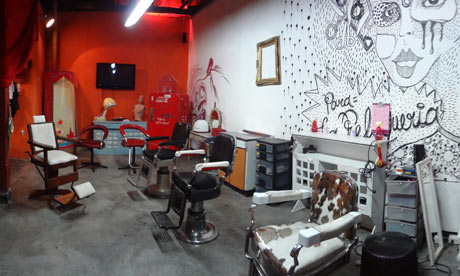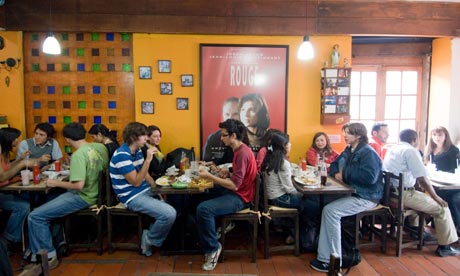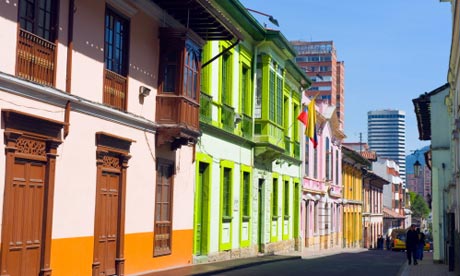Bogotá's age of rediscovery
With the conflict and curfews of the 1990s now behind it, Colombia's capital is bursting with creativity, clubs and great cuisine

Hair today … La Peluqueria artist studio/hairdresser in Bogotá, Colombia
"This is not a hairdressers," says a sign on the wall of a place called La Peluquería (The Hairdressers). "OK," I think, trying to overlook the fact that a woman is most definitely holding clippers to a client's head, as she stands in front of a retro dryer. "This is not a cultural centre, or a museum, or a gallery, or a cafe," it continues. I look around to find customers sipping coffee at a counter covered in work by local artists.
So what is it? This, it seems, is what modern Bogotá is doing best: making artistic ventures work by combining them with other activities. La Peluquería (lapeluqueriabogota.com) is certainly not a conventional hairdressers, with its graffitied walls and reclaimed mannequins. The stylists are all visual artists rather than trained hairdressers; on Wednesdays haircuts are free, provided you let them do as they please; and if you'd rather not take a radical Colombian hairdo home as a souvenir, you can also amuse yourself in the design shop or bar.
This is the first of many new hybrid venues I find as I explore the capital that for many years remained off travellers' radars. A little way to the north of the centre, an area called Parkway in La Soledad neighbourhood doesn't strike me as obviously creative – the "park" is a thin strip of grass down the middle of the main road, Carrera 24 – but I'm assured that good stuff goes on behind the doors of the 1940s buildings that run up its length.
Apparently, this was once a hangout for the city's most artistic residents and is now in the midst of a major regeneration. At number 37, bar La Trementina has recently expanded to include a bookshop-cum-gallery-cum-café, with space for live music and poetry readings (trementinacultural.com). A little further down, at number 41, is art-deco theatre Casa Ensamble (casaensamble.com) which also hosts art exhibitions and has a retro bar with occasional cabaret. Hiding just behind it on Carrera 25, the struggling Arlequín theatre has turned half its premises into a branch of a trendy burger diner, La Hamburguesería (lahamburgueseria.com).
Bogotá's landscape is changing rapidly. People who abandoned its centre for safer, outlying neighbourhoods at the height of the internal conflict in the 1990s are coming back. Meanwhile, tourism is moving beyond La Candelaria, the old colonial quarter, and is even making inroads into the city centre, which is where you'll find La Peluquería (on Carrera 3) and a new vegetarian restaurant, Reverdeser (Calle 17, 2-46).
 Cafe society in La Candelaria district of Bogotá. Photograph: Alamy
Cafe society in La Candelaria district of Bogotá. Photograph: Alamy Magdalena Barón already had a successful vegetarian restaurant in La Candelaria (Quinua y Amaranto), when she opened Reverdeser in April. "This part of town was the epicentre of the violence, so it had been abandoned," she says. "But now foreigners are buying property here and people aren't just using it as place to work. What we're trying to do [by opening here] is give importance back to the centre."
As Magdalena tells me this, I'm in her kitchen, washing vegetables. I've taken advantage of a £12 cookery course that allows customers to learn macrobiotic recipes while making their own lunch. Magdalena's not proprietorial about her recipes – which include quinoa empanadas – because her priority is spreading the word about Colombian cuisine: "The Spanish prohibited a lot of our indigenous foods, so now we are reclaiming them."
Following a similar principle is Mini Mal, a restaurant (combined with a design shop, of course) in another emerging area, Chapinero Alto in northern Bogotá, which is also known as Gay Hills (Carrera 4a, 57-52, +57 1 3475464, mini-mal.org). The name Mini Mal is a play on Spanish phrase, "menos mal" (least bad) in a nod to their aim to do minimal damage to the environment, while recognising that no business is footprint-free.
"We wanted to make Colombian food more sophisticated, but the we realised our work was already done," says owner Manuel, as I tuck into king prawns dyed with seeds that Colombian Indians traditionally use as face paint. Manuel informs me that Colombia is the second most biodiverse country on the planet, pointing out that juice menus in Bogotá – featuring fruit from the Amazon, the Caribbean and the Pacific – often run to a full page.
With such a range of ingredients, the city's culinary scene has come on hugely in recent years. There are some great, middle-ground places which combine tradition and innovation at good-value prices. One example is La Esquina in La Macarena neighbourhood (Carrera 4A, No 26A-04, +57 1 283 8685, cevicherialaesquina.com). The chef trained with Gordon Ramsay, but decided to specialise in affordable food that can be shared among friends, such as crab claws for under £6.
Home to a mix of actors, artists and students, La Macarena is a good area to stick around in after dinner. Bars range from old-school Vásquez y Cebollas (Calle 26, 4-68) to industrial minimalism at En Obra (Carrera 4A, 26A-37). Later, you can hop over to the more established nightlife areas around the pedestrianised Zona T, which is packed with people looking for a rumba (party). Two new places to try are El Coq (Calle 84, 14-02), a very popular DJ bar nearby with a tree growing through its middle, and La Destilería (Calle 85, 12-91), a martini lounge with drinks that come with champagne chasers and a garnish of edible ants, should you so desire.
 Bogotá's historic downtown. Photograph: Getty Images/Robert Harding World Imagery
Bogotá's historic downtown. Photograph: Getty Images/Robert Harding World Imagery Safety in Bogotá is now much like in any other South American city. The same rules apply: don't flash expensive cameras, avoid carrying valuables on the streets, and order radio taxis after dark. Bogotá, and Colombia in general, still has some no-go areas, so refer to a guidebook, tour operator or trusted local – most are very protective of foreigners. On the whole, the tourist board's campaign ("The only risk is wanting to stay") seems to be working: the number of foreign tourists visiting Colombia rose by 16% in the first five months of this year.
Before leaving the city, I make a stop at what has become one of Bogotá's most famous sights, aside from the Gold Museum and the Plaza de Bolivar. Part steakhouse, part nightclub, Andrés Carne de Res (+57 1 863 7880, andrescarnederes.com) is a local institution that is hard to put into words. Try imagining one of those houses where the owners almost bankrupt themselves by putting up excessive Christmas lights. Next combine that with a quirky little trattoria where every inch has been covered in surreal memorabilia. Now times that by a hundred.
With a capacity of 2,500, Andrés Carne de Res really is a spectacle and it's well worth driving the 45 minutes out of town to its original site in the town of Chía, now a suburb. (The newer version in the city centre is a bit TGI Fridays.) Opened almost 30 years ago, it really took off in the mid 1990s during the city's crime-fighting curfew, known popularly as la hora zanahoria (nerds' hour). When normal bars closed at 1am, the parties shifted here. Now, even though the curfew days are over, it remains hugely popular, so be sure to make a reservation, and expect to pay around £16 for a steak.
Insanely decorated steakhouses aside, the most interesting places in Bogotá almost all hide behind modest exteriors. Perhaps that's the thing about this city: it hasn't got a longstanding tradition of tourism, so it doesn't feel the need to play up to it and signpost its assets.
Whatever the reasons, the standout places are well worth seeking out and that's surely the best part of visiting any emerging destination.
• Air France (airfrance.co.uk) flies from Heathrow to Bogotá via Paris from £544 return. Hotel Casa de la Botica, in the historic La Candelaria district, has rooms from £59 (+57 1 745 0800, hotelcasadelabotica.com). Alma de Bogotá is a gay-friendly, converted mansion in Chapinero that charges from £90 for a double (+57 1 212 1800, hotelboutiquealma.com). Note that many hotels in Bogotá offer cheaper rates at weekends. More information from colombia.travel
No comments:
Post a Comment
Note: only a member of this blog may post a comment.